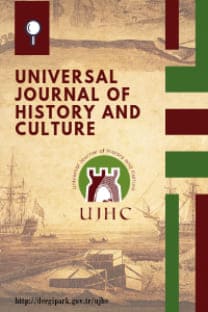Charles De Gaulle'ün İkinci Dünya Savaşı Konuşmalarıyla Birleşik Avrupa Vizyonu
Brexit anlaşması ile eski Fransa Cumhurbaşkanı Charles de Gaulle yeniden gündeme geliyor. İngiltere'nin (1963 ve 1967'de) AET'ye katılma başvurusunu veto etmesi bugün tekrar tartışılıyor. De Gaulle geçmişte Avrupa'nın birleşme sürecinin önünde bir engel olarak görülüyordu ancak bugün sezgisel düşünceye sahip anlayışlı bir politikacı olarak görülüyor. Bu temelde, siyasi yörüngesinin genel olarak yeniden değerlendirilmesi gerekir. Bu makale, De Gaulle'ün İkinci Dünya Savaşı'nda yaptığı konuşmalara odaklanıyor ve o dönemde bütünleşmiş bir Avrupa'yı nasıl tasavvur ettiğine dair açıklamalarla devam ediyor.
Anahtar Kelimeler:
Avrupa Birliği, Charles de Gaulle, Dış Politika, İkinci Dünya Savaşı
Charles De Gaulle’s Vision for a United Europe through his Second World War Speeches
Due to the Brexit agreement, the former French President Charles de Gaulle comes to the fore again. His veto of Britain’s application to join the EEC (in 1963 and 1967) becomes timely today. In the past, he was treated as an obstacle to the European unification process, but today he is seen as an insightful politician with intuitive thinking. On this basis, an overall re-evaluation of his political trajectory may be necessary. This article focuses upon the speeches de Gaulle gave in the Second World War and proceeds to some remarks on how he truly envisaged an integrated Europe during that period of time.
Keywords:
Charles de Gaulle, European Union, Foreign policy, Second World War,
___
- Caldwell, D. and Muller, R. (2007). The Luftwaffe over Germany: Defense of the Reich. London: Greenhill Books.
- Chopra, H. S. (1974). De Gaulle and European Unity. New Delhi: Abhinav Publications.
- De Gaulle, Ch. (1944). https://www.cia.gov/readingroom/docs/DOC_0000388720.pdf Speech delivered on March, 18.
- De Gaulle, Ch. (1944). Discours de guerre (juin 1940-décembre 1942). Paris: Egloff, Librairie de l’Université.
- De Gaulle, Ch. (1951). La France sera la France. Ce que veut Charles de Gaulle. Rassemblement du Peuple Français, Paris: Bouchy et Fils.
- De Gaulle, Ch. (1955). War Memoirs, vol. 1: The call to Honour, 1940-1942. J. Griffin (Trans.) London: Collins.
- Gordon, Ph. H. (1999). Charles de Gaulle and the Nuclear Revolution. J. L. Gaddis, Ph. H. Gordon, E. R. May, and J. Rosenberg (Ed.), Cold War Statesmen Confront the Bomb: Nuclear Diplomacy since 1945. Oxford: Oxford University Press, 216–235.
- Harrison, M. (1981). The Reluctant Ally: France and Atlantic Security. Baltimore: Johns Hopkins University Press.
- Herriot, É. (1930). The United States of Europe. D. J. Reginald (Trans.) New York: The Viking Press.
- Johnson, P. (1991). Modern Times: From the Twenties to the Nineties [Revised Edition]. New York: Harper-Collins.
- Johnson, P. (2008). Heroes: from Alexander the Great and Julius Caesar to Churchill and de Gaulle. New York: Harper-Collins.
- Kaufmann, J. E., Kaufmann, H. W., and Idzikowski, T. (2006). Fortress France: The Maginot Line and French Defenses in World War II. Westport: Praeger Security International.
- Knapp, A. (2021). Charles de Gaulle. New York: Routledge.
- Kolodziej, E. (1974). A. French international policy under De Gaulle and Pompidou: The Politics of Grandeur. Ithaca: Cornell University Press.
- Ludlow, N. P. (1997). Dealing with Britain: The Six and the First UK Application to the EEC. Cambridge: Cambridge University Press.
- Ludlow, N. P. (2010). From Words to Actions. Ch. Nünlist, A. Locher, and G. J. Martin. (Ed.) Globalizing de Gaulle: International Perspectives on French Foreign Policies, 1958-1969. Lanham: Lexington, 63–82.
- Martin, G. J. (2010). Conclusion: A Gaullist Grand Strategy? Ch. Nünlist, A. Locher, and G. J. Martin. (Ed.) Globalizing de Gaulle: International Perspectives on French Foreign Policies, 1958-1969. Lanham: Lexington, 291–308.
- Moravcsik, A. (2000a). De Gaulle between Grain and Grandeur: The Political Economy of French EC Policy, 1958-1970 (Part 1). Journal of Cold War Studies, 2 (2), 101–116.
- Moravcsik, A. (2000b). De Gaulle between Grain and Grandeur: The Political Economy of French EC Policy, 1958-1970 (Part 2). Journal of Cold War Studies, 2 (3), 4–68.
- Moravcsik, A. (2012). Charles de Gaulle and Europe: The New Revisionism. Journal of Cold War Studies, 14 (1), 53–77.
- Preston, D. (2020). Eight Days at Yalta: How Churchill, Roosevelt and Stalin Shaped the Post-War World. New York: Atlantic Monthly Press.
- Robinson, M. P. and Seignon, T. (2018). Division Leclerc: The Leclerc Column and Free French 2nd Armored Division 1943-46. Oxford: Osprey Publishing.
- Roobol, W. (2002). Aristide Briand's Plan: The Seed of European Unification. M. Spiering and M. Wintle (Ed.) Ideas of Europe since 1914: The Legacy of the First World War. Hampshire: Palgrave MacMillan, 32–46.
- Soutou, G. H. (2007). The Linkage between European Integration and Détente: The Contrasting Approaches of de Gaulle and Pompidou, 1965 to 1974. N. P. Ludlow (Ed.) European Integration and the Cold War: Ostpolitik-Westpolitik, 1965-1973. New York: Routledge, 11–35.
- Spaak, P. H. (1969). Combats Inachevés: vol. 2 De l’espoir aux deceptions. Paris: Fayard.
- Trachtenberg, M. (2000). De Gaulle, Moravcsik, and Europe. Journal of Cold War Studies, 2 (3), 101–116.
- Troitiño, D. R. (2008). De Gaulle and the European Communities. Proceedings of the Institute for European Studies, no. 4, International University Audentes. Tallinn: Tallinn University of Technology, 139–152
- Weigall D. and Stirk, P. (Ed). (1992). The Origins and Development of the European Community. Leicester: Leicester University Press.
- Whitman, R. C. (1998) From Civilian Power to Superpower? The International Identity of the European Union. London: MacMillan.
- ISSN: 2667-8179
- Başlangıç: 2019
- Yayıncı: Orhan TURAN
